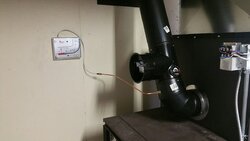Our Kuuma VF100 is entering it's 2nd day of service. I'm going to let the fire die down today, and install a nipple/copper pipe in the flue for the Dwyer manometer. Once that's done, I'd like to seal up the flue as best as possible.
I've read that the silicone stove sealant (I have the black Imperial stuff) is no good, in that it simply gets hot and cracks off. I've read the adhesive backed aluminum tape is no good as well; the metal tape lasts, but the adhesive does not. Granted, I think most of these comments were regarding wood stoves, with their much higher flue temps (the highest I've read on the Kuuma the past day is ~250, right at the outlet). I'm curious if these products would work better on the Kuuma, with the lower temps?
If not, what's the best way to seal up the seam on my flue pipe? I've read of using a fiberglass wrap with straps. I have easy access to the pipe, and it's a relatively short length (with several joints), so a wrap/clamp option would work for me.
I've read that the silicone stove sealant (I have the black Imperial stuff) is no good, in that it simply gets hot and cracks off. I've read the adhesive backed aluminum tape is no good as well; the metal tape lasts, but the adhesive does not. Granted, I think most of these comments were regarding wood stoves, with their much higher flue temps (the highest I've read on the Kuuma the past day is ~250, right at the outlet). I'm curious if these products would work better on the Kuuma, with the lower temps?
If not, what's the best way to seal up the seam on my flue pipe? I've read of using a fiberglass wrap with straps. I have easy access to the pipe, and it's a relatively short length (with several joints), so a wrap/clamp option would work for me.



 I just like knowing. This way you know what the norm is and if there ever comes a time where one must trouble shoot something you will now have the data to properly try to diagnose or you can make changes to something to see how it affects other things. I monitor my flue gas temp, draft, plenum temp and return air temp.
I just like knowing. This way you know what the norm is and if there ever comes a time where one must trouble shoot something you will now have the data to properly try to diagnose or you can make changes to something to see how it affects other things. I monitor my flue gas temp, draft, plenum temp and return air temp.